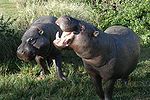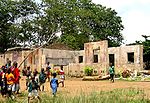Portal:Sierra Leone/Selected article
| This page is currently inactive and is retained for historical reference. Either the page is no longer relevant or consensus on its purpose has become unclear. To revive discussion, seek broader input via a forum such as the village pump. |

The Pygmy Hippopotamus (Choeropsis liberiensis or Hexaprotodon liberiensis) is a large mammal native to the forests and swamps of western Africa (the scientific species classification means "of Liberia", as this is where the vast majority lives). The pygmy hippo is reclusive and nocturnal. It is one of only two extant species in the hippopotamidae family, the other being its much larger cousin the common hippopotamus.
The pygmy hippopotamus displays many terrestrial adaptations, but like its larger cousin, it is semi-aquatic and relies on proximity to water to keep its skin moisturized and its body temperature cool. Behaviors such as mating and birth may occur in water or on land. The pygmy hippo is herbivorous, feeding on whatever ferns, broad-leaved plants, grasses and fruits it finds in the forests.
A rare nocturnal forest creature, the pygmy hippopotamus is a difficult animal to study in the wild; it also lives primarily in countries with a great degree of civil strife. Pygmy hippos lead mostly solitary lives; they are sometimes seen in pairs or threesomes, but never large pods like the common hippopotamus. Unlike the common hippopotamus, they are not known to be territorial. (read more . . . )

The balafon (bala, balaphone) is a resonated frame, wooden keyed percussion idiophone of West Africa; part of the idiophone family of tuned percussion instruments that includes the xylophone, marimba, glockenspiel, and the vibraphone. Sound is produced by striking the tuned keys with two padded sticks. Believed to have been developed independently of the Southern African and South American instruments now called the marimba, oral histories of the balafon date it to at least the rise of the Mali Empire in the 12th century CE. Balafon is a Manding name, but variations exist across West Africa, including the Balangi in Sierra Leone and the Gyil of the Dagara people from Ghana, Burkina Faso and Côte d'Ivoire. In the ancient Central African Kingdom of Kongo, it was called a palaku. A balafon can be either fixed-key (where the keys are strung over a fixed frame, usually with calabash resonators underneath) or free-key (where the keys are placed independently on any padded surface). The balafon usually has 17-21 keys, tuned to a tetratonic, pentatonic or heptatonic scale, depending on the culture of the musician. (read more . . . )

Media in Sierra Leone began with the introduction of the first modern printing press in Africa at the start of the nineteenth century. In the 1860s the country became a journalist hub for Africa with professional travelling to the country from across the continent. At the end of the nineteenth century the industry went into decline and when radio was introduced in the 1930s this became the primary communication media in the country. Print media is not widely read in Sierra Leone, especially outside Freetown, partially due to the low levels of literacy in the country. Among newspaper readership young people are likely to read newspapers weekly and older people daily. Radio is the most popular and most trusted media in Sierra Leone, with 85% of people having access to a radio and 72% of people in the country listening to the radio daily. Stations mainly consist of local commercial stations with a limited broadcast range combined with a few stations with national coverage. There are two national free terrestrial television stations in Sierra Leone but outside the capital Freetown television is not watched by a great many people. Internet access in Sierra Leone has been low but is on the increase, especially since the introduction of wireless services across the country. (read more . . . )

The Sierra Leone Civil War began in 1991, initiated by the Revolutionary United Front (RUF) under Foday Sankoh. Tens of thousands died and more than 2 million people (well over one-third of the population) were displaced because of the 9-year conflict. Neighbouring countries became host to significant numbers of refugees attempting to escape the civil war. It was officially declared over on 18 January 2002.
In 1985, Joseph Momoh, a military leader, was installed as president of Sierra Leone. One major opposition group consisted of students including Foday Sankoh, Abu Kanu, and Rashid Mansaray. Many students were expelled from the country and this group fled to Ghana and then Libya where they attended Muammar Gaddafi's secret service military training facility. The group recruited unemployed young men and students, but as the group grew, internal squabbles arose, and many left the group, some students to universities in Ghana, others back to Sierra Leone. However, others (including Kanu, Mansaray, and Sankoh) were still interested in revolution. The group then went to Kono District and toured the diamond mines, talking with workers about their situation, and spreading a revolutionary ideology.
Control of Sierra Leone's diamond industry was a primary cause of the war. Although endowed with abundant natural resources, Sierra Leone was ranked as the poorest country in the world by 1998. With the breakdown of all state structures, wide corridors of Sierra Leonean society were opened up to the trafficking of arms and ammunition. Recreational drugs also eroded national and regional security as well as facilitated crime within the country, precipitating illegal trade with both Liberia and Guinea. (Read more ...)

Bunce Island (also spelled "Bence," "Bense," or "Bance" at different periods) is the site of an 18th century British slave castle in the Republic of Sierra Leone. It is located deep within Freetown harbor. Located about 20 miles upriver from Sierra Leone's capital city of Freetown, Bunce Island lies in the Sierra Leone River, the estuary formed by the Rokel River and Port Loko Creek. Although just a tiny island only about 1650 feet long and 350 feet wide, its strategic position at the limit of navigation in Africa's largest natural harbor made it an ideal base for European slave merchants.
Bunce Island was first settled by English slave traders about 1670. During its early history the castle was operated by two London-based firms, the Gambia Adventurers and the Royal African Company of England, the later a "crown-chartered company," or parastatal, subsidized by the British government. The castle was not commercially successful at this period, but it served as a symbol of British influence in the region. This early phase of the castle's history came to an end in 1728 when Bunce Island was raided by an Afro-Portuguese competitor in the slave trade named José Lopez da Moura. It was abandoned until the mid-1740s. (read more . . . )
